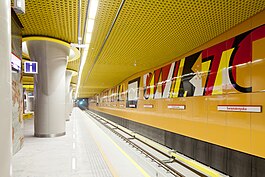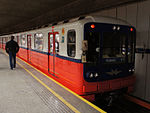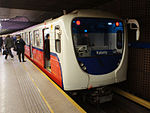Loading AI tools
Rapid transit system in Warsaw From Wikipedia, the free encyclopedia
The Warsaw Metro (Polish: Metro Warszawskie) is a rapid transit underground system serving the Polish capital Warsaw. It currently consists of two lines, the north–south M1 line which links central Warsaw with its densely populated northern and southern districts, and the east–west M2 line. Three more lines (M3, M4, and M5) are planned.[3] The system is operated by Metro Warszawskie, a company owned by the city, and managed by Public Transport Authority in Warsaw. As of 2024, it is the only metro system in Poland.
| Warsaw Metro | |
|---|---|
 | |
 M2 platform at Świętokrzyska station | |
| Overview | |
| Native name | Metro Warszawskie |
| Owner | City of Warsaw |
| Locale | Warsaw, Poland |
| Transit type | Rapid transit |
| Number of lines | 2 (3 more planned) |
| Number of stations | 39 |
| Annual ridership | 200.0 million (2023)[1] |
| Website | Metro Warszawskie Warsaw Public Transport |
| Operation | |
| Began operation | 7 April 1995 |
| Operator(s) | Metro Warszawskie |
| Technical | |
| System length | 41.3 km (25.7 mi)[2] |
| Track gauge | 1,435 mm (4 ft 8+1⁄2 in) standard gauge |
| Electrification | 750 V DC third rail |
The first section of M1 was opened in 1995 and the line was gradually extended until it reached its full length in October 2008. The contract for the construction of the initial central section of M2 was signed on 28 October 2009 and construction began on 16 August 2010.[4][5] The initial segment of M2, measuring 6.3 kilometres (3.9 miles) with seven stations,[2] one of which, Świętokrzyska, includes a transfer between the two lines, was opened on 8 March 2015.[6][7] The line's further extensions have been opening since 2019, and it is expected to be completed in 2026, when it will have 21 stations.[8][9]
In February 2023, the mayor of Warsaw Rafał Trzaskowski released a plan for the Warsaw Metro, calling for five metro lines by the year 2050. The plan includes constructing two additional M1 stations, Plac Konstytucji and Muranów, extending M2 line to Marymont and Ursus-Niedźwiadek, as well as construction of three new lines: M3, M4, and M5. With those extensions the metro would directly serve 17 out of Warsaw’s 18 districts.[10]

Plans to build an underground rail system in Warsaw date as far back as 1918, when the idea was first proposed after Warsaw regained its status as Poland's capital city. An underground railway system was expected to solve the transport difficulties of the densely built city center. Proper preliminary planning and boring work were initiated by the Warsaw Tramway Authority in 1925, with construction expected to start in the late 1920s. The Great Depression buried those plans as Poland and the world were gripped by economic hardship.[11]
In 1934, with the election of a new mayor of Warsaw, Stefan Starzyński, work was to resume on the metro. The mayor dusted off the plans from the mid-1920s, and with some minor adjustments, construction of the metro was planned to start by the late 1930s, with a projected finishing date of the first of two projected lines scheduled for the mid-1940s. By then, the subway network was to consist of two lines. Line M1 (north–south line, 7.4 km or 4.6 mi long) was to follow a route similar to the present-day line and was to link the southernmost borough of Mokotów with the city center and the northern borough of Żoliborz. This line was to be connected with the newly constructed Warszawa Główna railway station and the railway tunnel crossing the city from west to east. Line M2 (east–west, 6.36 km or 3.95 mi long) was to start beneath the westernmost borough of Wola, proceed along the Chłodna street to the pivotal station beneath the Saxon Square and then further eastwards to the Vistula river escarpment. There, the line was to go overground, cross the river through a newly built bridge and proceed to the easternmost railway station of Warszawa Wschodnia. Altogether, in 35 years, 7 lines were to be built. The works finally started in 1938, but World War II brought an end to the ambitious undertaking. The short trace tunnels made in 1938 serve as a wine cellar today.
The city suffered heavily during World War II. Although the majority of pre-war projects were destroyed during the war, most of the engineers behind their creations survived and returned to their city to take part in its rebirth. However, the new Communist authorities of Poland envisioned a city completely different from what it had been before the war. As the "ideal" communist city, Warsaw was to be decentralized and the need to commute to the city center was reduced. Thus, the Office for the Reconstruction of Warsaw (BOS) commissioned several engineers to prepare a project for a fast urban railway (SKM) crossing the city in a deep cutting. Although to a large extent it was to follow line 1 of the pre-war plans, only the central stations were to be located underground. However, by the end of the decade, the project was cancelled. Instead, in 1948 communist planners developed a different concept with the new SKM morphing into a rapid transit line at a depth of up to 15 metres (49 feet). The suggested north–south direction, with three parallel branches of the same line in the city center, corresponded to the planned development of the city along the Vistula. The works, however, never started and this project was also abandoned.

In the 1950s, as the Cold War raged on, Soviet strategic plans required that a secure transport link across the river Vistula be built. One of the ways to achieve this was to create a deep metro system in Warsaw (pl:Metro głębokie w Warszawie; up to 46 m (150 ft) beneath the ground), which would be interlinked with the rail network and could serve as an underground conduit for transporting troops. Plans assumed that the first line (about 11 km or 7 mi long) would lie along a north–south axis, with a branch of the same line crossing the Vistula river in the city centre. The construction works started almost simultaneously at 17 different points on both sides of the river. By 1953 only 771 m (843 yd) of tunnels had been built; after the death of Joseph Stalin and the start of a period of détente, all work was halted under the pretext of technical difficulties. In the following years, only one junction tunnel and one shield-driven tunnel were continued. These works were undertaken experimentally, to discover the best driving methods suitable for the ground conditions beneath Warsaw (pliocene clay formations layer spread beneath quaternary soils). All work was halted in 1957, and the tunnel eventually flooded in 1960.
Since 1955, planners returned to the old idea of a shallow metro network. However, the planning phase proceeded at a very slow pace and the economic situation prevented all successive governments from actually starting serious work. Finally, in 1983, the program was approved by the government and the first tunnels were built. Lack of funds, technical difficulties, shortage of materials and outdated tunnelling methods meant that the work progressed very slowly, sometimes at a speed no greater than 2 m (6 ft 7 in) per day.
The Metro was opened on 7 April 1995 with a total of 11 stations.[12] The initial line, M1, has 21 stations over a route distance of 22.7 km (14.1 mi).
Many of the station name announcements are narrated by Ksawery Jasieński, with some newer stations using recordings by Maciej Gudowski.[13]
This is missing information about construction and opening of the initial segment of the M2 line. (May 2024) |
On 11 March 2016, a 1 billion PLN (€225 million) contract was awarded to the Italian company Astaldi to build the first phase of the north-east M2 extension with 3.2 kilometres (2.0 mi) of track and 3 stations: Szwedzka, Targówek Mieszkaniowy, and Trocka. On 30 April, construction on Szwedzka station started, and on 2 May, the other two stations started construction. Construction of this phase took 3 years, until it opened on 15 September 2019. Initially, this extension was to be built at the same time as the west extension which was due to be completed in 2020. However, due to delays, it was decided that each extension will be built at its own pace. The extension from Rondo Daszyńskiego to Księcia Janusza was opened on 4 April 2020, and the extension from Księcia Janusza to Bemowo was opened on 30 June 2022. On 28 September 2022, the extension of M2 consisting of three new stations: Zacisze, Kondratowicza, and Bródno was opened to the public.
Turkish construction firm Gülermak was commissioned in November 2018 to complete the three western-most stations on the line – Lazurowa, Chrzanów and Karolin.[14]
| Segment | Line | Length (km)[citation needed] | Date opened |
|---|---|---|---|
| Kabaty – Politechnika | M1 | 11.1 | 7 April 1995 |
| Politechnika – Centrum | 1.4 | 26 May 1998 | |
| Centrum – Ratusz Arsenał | 1.7 | 11 May 2001 | |
| Ratusz Arsenał – Dworzec Gdański | 1.5 | 20 December 2003 | |
| Dworzec Gdański – Plac Wilsona | 1.5 | 8 April 2005 | |
| Plac Wilsona – Marymont | 0.9 | 29 December 2006 | |
| Marymont – Słodowiec | 1.0 | 23 April 2008 | |
| Słodowiec – Młociny | 2.6 | 25 October 2008[15] | |
| Rondo Daszyńskiego – Dworzec Wileński | M2 | 6.3[2] | 8 March 2015[6] |
| Dworzec Wileński – Trocka | 3.1 | 15 September 2019[16] | |
| Rondo Daszyńskiego – Księcia Janusza | 3.4 | 4 April 2020[17] | |
| Księcia Janusza – Bemowo | 2.1 | 30 June 2022[18] | |
| Trocka – Bródno | 4 | 28 September 2022[19] | |
| Total: 39 stations | 41.3 km[2] |

| # | Opened | Length | Stations |
|---|---|---|---|
| M1 | 1995–2008 | 22.7 km (14.1 mi)[2] | 21, 23 planned in total[2] |
| M2 | 2015–present | 18.6 km (11.6 mi)[20] | 18, 28 planned in total[2] |
| M3 | by 2050 | 0 km (0 mi) | 1, 15 planned in total[10] |
| M4 | by 2050 | 0 km (0 mi) | 0, 23 planned in total[10] |
| M5 | by 2050 | 0 km (0 mi) | 0, 20 planned in total[10] |

| Line | Current stock | Image | Introduced | Sets | Length (m/ft) | Seats | Capacity |
|---|---|---|---|---|---|---|---|
| M1 | Metrovagonmash (81-717.3/714.3) |
 |
1989 | 1[21] | 115.26/378.15 | 260 | 1200 |
| M1 | Alstom (Alstom Metropolis 98B) |
 |
2000–2005 | 18 | 116.74/383.01 | 264 | 1454 |
| M1 | Siemens Mobility (Siemens Inspiro) |
 |
2013,2015 | 35 | 117.7/386 | 232 | 1500 |
| M2 | |||||||
| M1 | Škoda Transportation (Škoda Varsovia) |
 |
2022 | 37 | 119.01/390.45 | 230 | 1500 |
| M2 |
Initially, all of the trains were Russian-built 81-series metro cars. They first arrived in Warsaw in 1990 as a "gift" from the USSR, five years before the Metro's opening, from the Metrovagonmash plant in Mytishchi near Moscow (model 81-717.3/714.3 - 10 carriages). Subsequent trains arrived from Saint Petersburg's Vagonmash (I. E. Yegorov) Plant in 1994 (81-572/573 - 32 carriages) and an additional 18 81-572.1/573.1 carriages in 1997.[22]
In 1995 the metro began operation with 14 three-car trainsets, with 5 minute intervals between trains during rush hours. With the opening of the Centrum metro stations the trains were extended to four cars and their number was increased to 15.[23]
In 1998, 108 new carriages of the modern Metropolis family were ordered from the French company Alstom, forming 18 six-car trainsets. These were all delivered by 2005[24] (24 were produced in Barcelona and the remainder in the Alstom Konstal plant in Chorzów).[25]
In 2006, additional 30 carriages were ordered from Russia to extend the existing 81-series to the target length of six cars, with deliveries taking place up to 2007.
In 2007 five new Russian 81-series trains with redesigned front-ends were purchased, with the contract extended to seven in 2009.
In February 2011, an order was signed with German manufacturer Siemens for 35 complete trains from their new Inspiro line. A large number of these were manufactured in Poland by Newag. The first five trains were put into service in 2013. However, in November 2013 a fire broke out in one of the carriages and for safety reasons all five trains were withdrawn from operation until the cause of the fire was determined. Once the investigation was completed the five new Inspiro trains were placed back into service in March 2014. In 2012, a non-revenue diesel shunting locomotive, classified as ZPS LM-400.00, was manufactured by Zakład Pojazdów Szynowych in Stargard, designed especially for shunting Inspiro trains at the Kabaty depot.
By 2020, the Siemens Inspiro formed the majority of the operating rolling stock.
Originally the 81-series and Alstom Metropolis trains were painted in two horizontal stripes of equal width, the upper one white and the lower one red, with a blue bar identifying the M1 line between them. For the Simens Inspiro a livery with a yellow and red stripe under the windows was chosen in order to resemble the color scheme of the surface public transport taken from the flag of Warsaw. Subsequently the older trains have had the blue bar replaced with a yellow one during scheduled refurbishment.[26]
In January 2020, Škoda Transportation was awarded a new contract for 37 new, single-space trains, named the Varsovia. The first EMU arrived in Warsaw on April 25, 2022, in October the first unit entered regular passenger service on the M1 line.[27]
With the delivery of the Škoda Varsovia the obsolete 81-series is being gradually retired, units in good technical condition have been donated for spare parts to Kyiv[28] and Kharkiv,[29] where trains of the type are still common. A single trainset of this is to be kept in working order as a museum exhibit and seasonal operation while 3 others remain in Warsaw for spare parts.
A single depot is located south of the Kabaty station. There is a single-track connection (PKP rail line 937) between the depot and Warszawa Okęcie railway station on the PKP rail network. This link is not electrified and is used only for an occasional rolling-stock transfer. A second depot (Karolin) is currently under construction and is expected to open in 2026. A third depot (Kozia Górka) is planned to be built as part of the first section of the M3 line from Stadion Narodowy to Gocław.
| Line | Current stock | Image | Introduced | Retired | Sets | Length (m/ft) | Seats | Capacity |
|---|---|---|---|---|---|---|---|---|
| M1 | Metrovagonmash (81-717.3/714.3) |
 |
1990, 2006 | 2023 | 15 | 115.26/378.15 | 260 | 1200 |
| Vagonmash (81-572/573) |
 |
1994-1997 | 2023 | |||||
| Vagonmash (81-572.2/573.2) |
 |
2009 | 2023 | 7 |
Despite being retired in Poland, the 81-series trains are still widespread in several V4 countries and are well-known in Europe. Compared to west European metro systems (such as Berlin U-Bahn or Paris Metro), these trains can maintain higher average speeds, 80 km/h maximum and 35-40 km/h average, there were produced in several thousands, so their spare parts are still on high demand abroad. So, some trains were donated to Ukraine. Unlike, for example, Hungary,[30] Ukraine decided not to buy the Russian spare parts, as Polish ones already met this demand.[31]
This article needs additional citations for verification. (May 2024) |


The M1 line does not pass directly under Warsaw's Old Town, the city's main tourist attraction, which has few public transport links, passing it about 600 metres (2,000 feet) to the west instead. It also does not directly connect to the Warszawa Central railway station, with the nearest stop being over 400 metres (1,300 feet) to the east. Until the opening of M2 in March 2015, the metro system was confined to the western bank of Vistula, thus doing nothing to ease traffic problems on Warsaw's bridges: a major bottleneck between the city center and the eastern Praga district. Plans for a third line to Warsaw Chopin Airport have been abandoned for the foreseeable future, with the airport served by a newly built railway station instead.
Transport planners have suggested that the WKD, a light rail line that runs to the western suburbs, could be integrated with the city's tram system, or be more closely tied to the metro and a future suburban rail network, or both. The first such plans were prepared in the late 1930s and the railway tunnel running below the city center was to be shared by both the railways and the metro. The WKD, PKP and Warsaw Metro systems are integrated and Warsaw city travel cards are also valid in the suburban trains operated by SKM and KM.

In 2009, the Warsaw Metro won two "Metro Award" prizes in the categories of "Special Merit Award for Commitment to the Environment" and "Best Maintenance Programme". These were followed by the Most Improved Metro award in 2011.[33] The system consistently receives very high ratings among its passengers; a survey conducted in September 2014 indicated that 98% of the respondents rated it as good or very good.[34]
Seamless Wikipedia browsing. On steroids.
Every time you click a link to Wikipedia, Wiktionary or Wikiquote in your browser's search results, it will show the modern Wikiwand interface.
Wikiwand extension is a five stars, simple, with minimum permission required to keep your browsing private, safe and transparent.